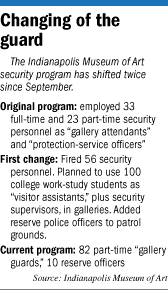Subscriber Benefit
As a subscriber you can listen to articles at work, in the car, or while you work out. Subscribe NowVisitors to a rare exhibit of Nigerian art that opens at the Indianapolis Museum of Art this month will spot men and women wearing light-blue polo shirts in the galleries, but they won’t be from the controversial “visitor assistant” program the museum launched last fall.
Museum officials in March dropped that program, which relied on college-student labor and emphasized visitor service. The move came after IUPUI vetoed IMA’s plan to replace its old guard staff with federally funded work-study students. The museum has returned to traditional  gallery guards, but they now wear polo shirts rather than the uniforms guards used to wear.
gallery guards, but they now wear polo shirts rather than the uniforms guards used to wear.
The use of visitor assistants had drawn scrutiny from the National Endowment for the Arts, which is insuring “Dynasty and Divinity: Ife Art in Ancient Nigeria,” opening July 8. The exhibit is organized by the Museum for African Art in Long Island, which was responsible for ensuring all participating museums met the federal agency’s standards.
“They were concerned [whether] the visitor assistants were adequately trained,” Amanda Thompson, registrar at the African art museum, said of NEA officials. She added that the Nigerian exhibit is the first from Africa to fall under the NEA’s indemnity insurance program for extremely valuable works.
“Most of these objects have not left Nigeria before,” Thompson said.
Thompson and the NEA ultimately signed off on the visitor assistants. Museum spokeswoman Katie Zarich said the switch from “visitor assistants” to “gallery guards” was not driven by negative feedback.
The change wasn’t in name only. Zarich said the gallery guards’ main focus is on protecting art. While the IMA wants the guards to be more approachable—thus the polo shirts rather than blazers—Zarich said they won’t make a point of engaging visitors.
Zarich said the museum still hopes to add visitor-focused personnel in the galleries at some point in the future. “What comes first is protecting the art. That’s what we had to deal with first.”
Nevertheless, the word “guard” in the title might go a long way with future art lenders or insurers. Thompson said she asked a lot of questions about the visitor assistants, which were also trained in security procedures.
“A lot of it is knee-jerk reaction,” she said. “People will hook onto reasons not to lend some objects.”
The visitor assistants were controversial because they replaced 56 full- and part-time guards the IMA laid off last September. Chief Operating Officer Nick Cameron’s goal was to improve the visitor experience, along with security, while saving the museum $600,000 a year.
But the savings would have come from the federally funded work-study program at IUPUI, which pays three-quarters of student wages. U.S. Department of Education rules prohibit using federal funds to displace regular labor, so IUPUI halted the program shortly after the guards were let go last September.
The IMA argued it wasn’t replacing the guards with students because the students had a different job description, centered on visitor services.
The university finally decided in March that the museum could use work-study students, but they couldn’t be seen as overlapping with security, Zarich said. The museum now has 11 IUPUI students working as “visitor information associates” on the grounds of the Art and Nature Park. The visitor services department, not security, supervises their work.
Merging customer service and security is common in retail—think greeters at Wal-Mart. It’s also not unheard of at museums. The Children’s Museum of Indianapolis takes a similar approach.
While putting visitor assistants in the galleries, Cameron added reserve police officers to patrol the campus and kept a handful of security personnel to work surveillance and supervise.
The IMA still has 10 reserve officers, in addition to the 82 gallery guards, who are all part-time employees, Zarich said.
The IMA won’t be able to shave much off its $2.2 million security budget this fiscal year, which ended June 30, Zarich said. Next year, the museum hopes to save $500,000, mainly because the gallery guards work a maximum of 15 hours per week. The visitor assistants earned $10 per hour. The gallery guards who were let go earned an average $11.50 per hour.
Once the security program was settled, the IMA invited the fired staffers to apply for the new guard jobs. Five did and were hired. The museum also hired some of the work-study students.
Not everyone who walks museum galleries needs to be highly trained in security, said museum security consultant Steve Layne of Denver-based Layne Consultants International.
But Layne also doubts a crew of students who change by the semester could have been as effective as regular gallery attendants.
“They take ownership. They know where every item in the collection belongs,” he said. “It’s very difficult to train somebody who does it a couple days a week to take that kind of ownership.”•
Please enable JavaScript to view this content.
